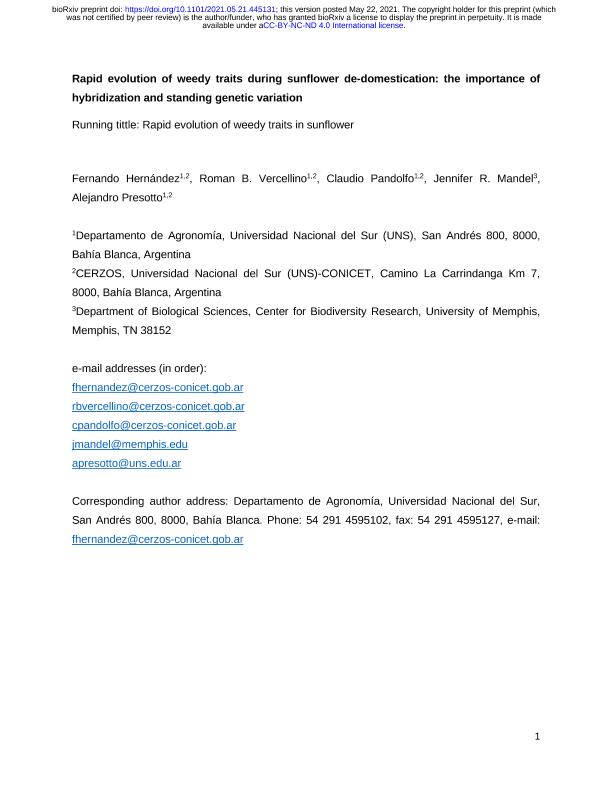Mostrar el registro sencillo del ítem
dc.contributor.author
Hernández, Fernando

dc.contributor.author
Vercellino, Román Boris

dc.contributor.author
Pandolfo, Claudio Ezequiel

dc.contributor.author
Mandel, Jennifer R.
dc.contributor.author
Presotto, Alejandro Daniel

dc.date.available
2022-03-08T15:15:19Z
dc.date.issued
2021-05
dc.identifier.citation
Hernández, Fernando; Vercellino, Román Boris; Pandolfo, Claudio Ezequiel; Mandel, Jennifer R.; Presotto, Alejandro Daniel; Rapid evolution of weedy traits during sunflower de-domestication: the importance of hybridization and standing genetic variation; bioRxiv; bioRxiv; 5-2021; 1-35
dc.identifier.issn
2692-8205
dc.identifier.uri
http://hdl.handle.net/11336/153050
dc.description.abstract
Hybridization between crops and their wild relatives may promote the evolution of de-domesticated (feral) weeds. Wild sunflower is typically found in ruderal environments, but crop-wild hybridization may facilitate the evolution of weedy biotypes. Using one crop-specific mitochondrial marker (CMS-PET1) and 14 nuclear SSR markers, we studied the origin and genetic diversity of BRW, a recently discovered weedy biotype. Then, using a resurrection approach, we tested for rapid evolution of weedy traits (seed dormancy, herbicide resistance, and competitive ability) by sampling weedy and wild biotypes 10 years apart (2007 and 2017). All the weedy plants present the CMS-PET1 cytotype, confirming their feral origin. At the nuclear markers, BRW showed higher genetic diversity than the cultivated lines, as high genetic diversity as the most diverse wild biotypes, and low differentiation with one wild biotype, suggesting that wild hybridization increased the genetic diversity of the feral BRW. Regarding weedy trait evolution, we found support for rapid evolution towards higher seed dormancy, but not for higher competitive ability or herbicide resistance. Standing genetic variation probably facilitated the evolution of seed dormancy and limited the evolution of herbicide resistance, as no resistant alleles were found in the ancestral biotype. Our results demonstrate that natural crop-wild hybrids can evolve quickly in farmers? fields, leading to the establishment of weedy biotypes of cultivated origin. Although herbicide resistance did not evolve in BRW, management strategies aimed at preventing the evolution of resistance should be a priority in order to avoid the emergence and spread of herbicide resistant biotypes in Argentina.
dc.format
application/pdf
dc.language.iso
eng
dc.publisher
bioRxiv
dc.rights
info:eu-repo/semantics/openAccess
dc.rights.uri
https://creativecommons.org/licenses/by-nc-nd/2.5/ar/
dc.subject
RAPID EVOLUTION
dc.subject
HYBRIDIZATION
dc.subject
SUNFLOWER
dc.subject
SEED DORMANCY
dc.subject.classification
Ecología

dc.subject.classification
Ciencias Biológicas

dc.subject.classification
CIENCIAS NATURALES Y EXACTAS

dc.subject.classification
Otras Ciencias Agrícolas

dc.subject.classification
Otras Ciencias Agrícolas

dc.subject.classification
CIENCIAS AGRÍCOLAS

dc.title
Rapid evolution of weedy traits during sunflower de-domestication: the importance of hybridization and standing genetic variation
dc.type
info:eu-repo/semantics/article
dc.type
info:ar-repo/semantics/artículo
dc.type
info:eu-repo/semantics/publishedVersion
dc.date.updated
2022-02-21T19:31:35Z
dc.journal.pagination
1-35
dc.journal.pais
Estados Unidos

dc.description.fil
Fil: Hernández, Fernando. Consejo Nacional de Investigaciones Científicas y Técnicas. Centro Científico Tecnológico Conicet - Bahía Blanca. Centro de Recursos Naturales Renovables de la Zona Semiárida. Universidad Nacional del Sur. Centro de Recursos Naturales Renovables de la Zona Semiárida; Argentina. Universidad Nacional del Sur. Departamento de Agronomía; Argentina
dc.description.fil
Fil: Vercellino, Román Boris. Consejo Nacional de Investigaciones Científicas y Técnicas. Centro Científico Tecnológico Conicet - Bahía Blanca. Centro de Recursos Naturales Renovables de la Zona Semiárida. Universidad Nacional del Sur. Centro de Recursos Naturales Renovables de la Zona Semiárida; Argentina. Universidad Nacional del Sur. Departamento de Agronomía; Argentina
dc.description.fil
Fil: Pandolfo, Claudio Ezequiel. Consejo Nacional de Investigaciones Científicas y Técnicas. Centro Científico Tecnológico Conicet - Bahía Blanca. Centro de Recursos Naturales Renovables de la Zona Semiárida. Universidad Nacional del Sur. Centro de Recursos Naturales Renovables de la Zona Semiárida; Argentina. Universidad Nacional del Sur. Departamento de Agronomía; Argentina
dc.description.fil
Fil: Mandel, Jennifer R.. University of Memphis; Estados Unidos
dc.description.fil
Fil: Presotto, Alejandro Daniel. Consejo Nacional de Investigaciones Científicas y Técnicas. Centro Científico Tecnológico Conicet - Bahía Blanca. Centro de Recursos Naturales Renovables de la Zona Semiárida. Universidad Nacional del Sur. Centro de Recursos Naturales Renovables de la Zona Semiárida; Argentina. Universidad Nacional del Sur. Departamento de Agronomía; Argentina
dc.journal.title
bioRxiv
dc.relation.alternativeid
info:eu-repo/semantics/altIdentifier/url/https://www.biorxiv.org/content/10.1101/2021.05.21.445131v1
dc.relation.alternativeid
info:eu-repo/semantics/altIdentifier/doi/https://doi.org/10.1101/2021.05.21.445131
Archivos asociados
